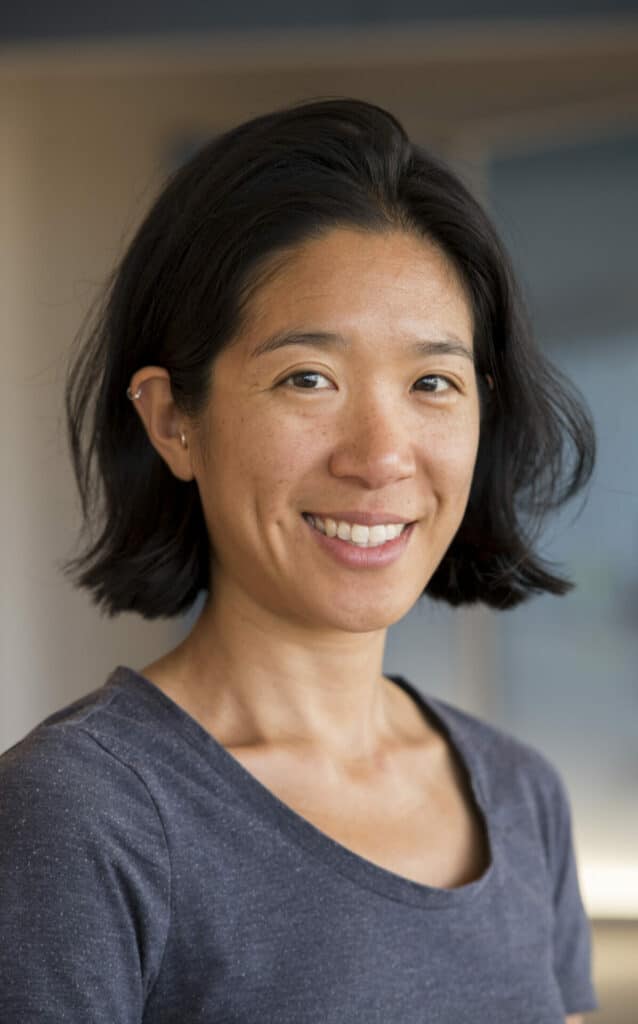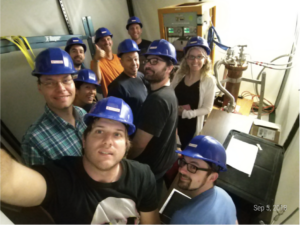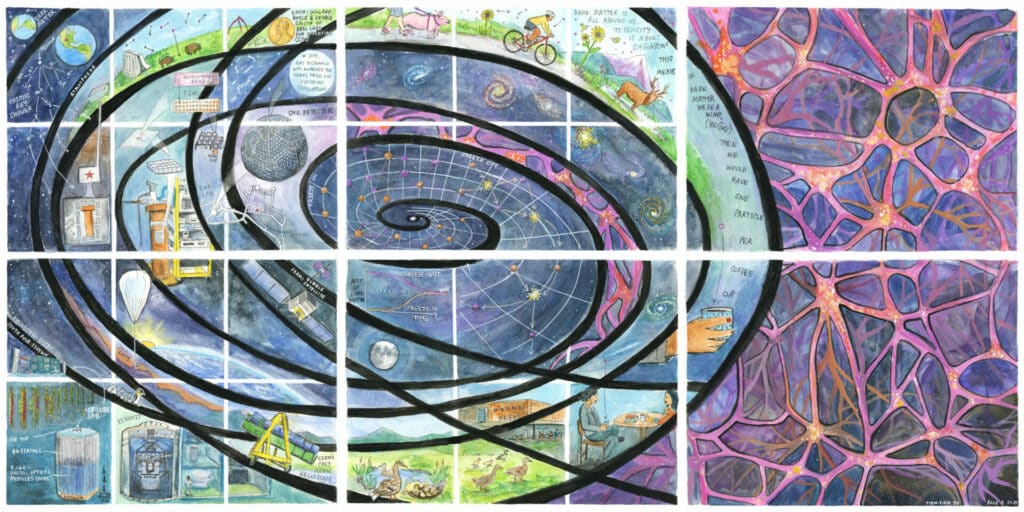Tien-Tien Yu Repurposes Old Data For New Science

Tien-Tien Yu applies a thrift store-like strategy to physics research. The University of Oregon professor works to repurpose existing datasets to ask new scientific questions. For example, in 2022, she and two colleagues proposed a way to take data collected in CERN’s NA62 — an experiment designed to look for rare decay products of an unstable particle called a kaon — and reanalyze it to study dark matter instead.
“I like to see what new questions you can ask with data that’s already been collected,” says Yu, who studies phenomenology, the theory behind experiments. “Maybe it’s the frugal part of me, but it’s really fun.” Her approach squeezes more science out of particle physics’ notoriously expensive machines, like the Large Hadron Collider, with its $4.8 billion price tag.
Yu has wide-ranging pursuits outside of research, too: she’s a member of the physicist activist group, Particles For Justice, which works to foster a more inclusive physics community. She also co-founded the Science and Comics Initiative at her university, where art students collaborate with physicists to depict their research using illustration. Yu spoke to 1400 Degrees about her physics career, her experiences living all over the world, and how it informs her role in shaping physics culture.
You’re a theorist, but you also study experimental results. What kinds of research questions attract you?
I work in phenomenology, which means I study physical phenomena that you can test experimentally. It’s the boundary between theory and experiment.
I like to reinterpret experimental data for models that they were not built to study. A lot of phenomenologists work this way. In 2017, my colleagues and I reanalyzed data taken by the XENON collaboration, which operates a dark matter detector in Italy. XENON looks for relatively heavy dark matter particles known as WIMPs, but we looked at the data for dark matter particles more than 100 times lighter. What XENON treated as background, we considered as our signal. Our analysis of XENON’s results motivated us to build SENSEI, a dark matter detector located in Ontario, Canada, to look for lighter dark matter.
What does SENSEI do?

SENSEI is the first dedicated dark matter detector to look for dark matter in the mass range between a mega-electron-volt and a giga-electron volt. This range corresponds to particles a little bit lighter than a proton. To search for this type of dark matter, we look for it interacting with electrons in our detector, which is made of silicon. The dark matter particle would nudge the electron loose of a silicon atom, allowing it to flow in the material, and we would detect that electron. This dark matter candidate requires another type of particle to mediate the interaction with the electron. This is appealing because the universe has five times as much dark matter than regular matter, which consists of many species—electrons, quarks, and so on. So you might expect dark matter to be more than one species too.
SENSEI also wasn’t costly. Researchers were already using similar silicon detectors to look for other types of dark matter, and we could look for our proposed signals by just tweaking those existing setups.
How did you decide to become a physicist?
As a high school senior, I took an incredible astrophysics course at Middle Tennessee State University, where my mom taught history. That got me considering physics as a college major. But the humanities were also appealing. In undergrad, I had existential crises every other month, as I wrestled with choosing sociology, anthropology, or physics as a major. I chose physics because it seemed the most practical, with the most transferable skills.
But I wasn’t sure about attending graduate school right away. I felt super burnt out after graduation. I moved to China for a year for a cosmology research internship at the Kavli Institute in Beijing. I found that I enjoyed research, so I applied to grad schools. That was around the time that the LHC turned on in 2008. It was a good time to learn particle physics, and a lot of my graduate school research was in collider phenomenology.
What was it like to grow up in Tennessee?
My family moved there from southern California when I was nine, because my mom got hired as a professor. It was a culture shock, going from a huge Asian-American community to a place where I was one of two Asians in my school. I remember feeling not quite like everybody else. We aren’t Christian, but everybody else went to church. Our teachers didn’t assign homework on Wednesdays, because Wednesday night was church night.
But I appreciated growing up there. In high school, I did dressage, which is like ballet for horses. I got my start riding horses owned by a woman who lived in the countryside. She hadn’t gone to college, and her husband and son were in the National Guard. They invited me into a part of society often excluded or underrepresented in academia. They were incredibly welcoming and nice, and I don’t know that I would have gotten to know people like them if I never moved to Tennessee. I went to college at the University of Chicago, with a lot of students who had attended fancy prep schools and thought the south was so backwards and racist. I felt defensive because the South was my home, with kind people who were more complex than how my classmates painted them to be. Also, people are racist everywhere. At least in the South, you know what you’re dealing with.
How did living in China shape you?
I improved my Chinese, which I grew up speaking at home. I also realized I felt shame growing up Asian in America. In Beijing, some non-Chinese friends would make fun of cultural quirks in China. For example, some Americans would ridicule Chinese students because they seemed to accept Internet censorship of political topics. Some Americans interpreted that acceptance as naïveté and ignorance. I would play along with these conversations. I had a friend who immigrated to California from China when she was young, and she thought we should not be playing along, because it’s our culture. She helped me realize I could feel proud for where my family comes from. Also, when I got to know a Chinese student, he told me that of course they care about politics. They don’t talk about these topics with strangers, because they consider it good manners to be discreet.

You’re a member of Particles for Justice, a group of physicists active in social justice movements. How did you join the group?
The group came together shortly after the presentation that Alessandro Strumia gave at CERN in 2018. [Editor’s note: Strumia, a particle physicist, gave a presentation in which he claimed the work of female physicists was worse than male physicists. CERN cut ties with Strumia in 2019.] I didn’t attend the talk, but after I spent two years at CERN, we had interacted a lot, and I wasn’t too surprised at what transpired.
His talk pissed me off. My friend, Seyda Ipek, [a physicist at Carleton University in Canada], had posted on social media why his talk was so inaccurate and problematic. I told her I appreciated the post, and she added me to a group on Slack of people coming together to discuss what happened. We felt we needed to respond. Not only was he being sexist, but he was saying inaccurate things, and that should come with repercussions. We also wanted people to realize that anyone can come together and form their own group for a cause.
CERN didn’t receive our response particularly well. Some people thought we were making it too big of a deal, and others thought we had an American-centric viewpoint. But it got people talking, which was the first step to acknowledging something wasn’t okay.
Two years later, Particles for Justice was also a driving force behind the Strike 4 Black Lives on June 10, 2020, where Black academics paused work for the day, and other participants did social justice work instead of their day-to-day research. What did you do on the day of the strike?
Instead of talking about research in our weekly SENSEI meeting, we talked about how our collaboration could do better to improve physics culture. One of my colleagues grew up in apartheid South Africa, and he talked about that. We brainstormed what our collaboration could do to help fix racial inequalities within physics. We also started looking into fellowship programs that we could try to do with Fermilab.
I also read about the relationship between Asian and Black Americans and their activism. Both communities have experienced similar struggles, yet they also harbor antagonism. I wanted to understand those dynamics better. For example, I learned that many Asian Americans were involved with the Black Panther movement.
What do you see as your responsibility as a professor to shape physics culture?
I have a huge role. I’m most effective locally, within my department. I try to speak up in moments such as admissions committee meetings, to get people to think more about their biases when they rank applicants.
But being vocal is outside of my comfort zone. Until 2018, I would get upset when I saw inequality and injustice, but I never took action. I didn’t want to bring attention to myself. But when I started my faculty job that year, I realized I was in a position of authority. If I didn’t speak up then, when would I? I have a duty to set an example for the younger generation.
Sophia Chen is a science writer who covers physics, space, and anything involving numbers. Find more of her work at sophurky.com.
Want to recommend a physicist for us to profile? Write to info@1400degrees.org. All interviews are edited for brevity and clarity.
